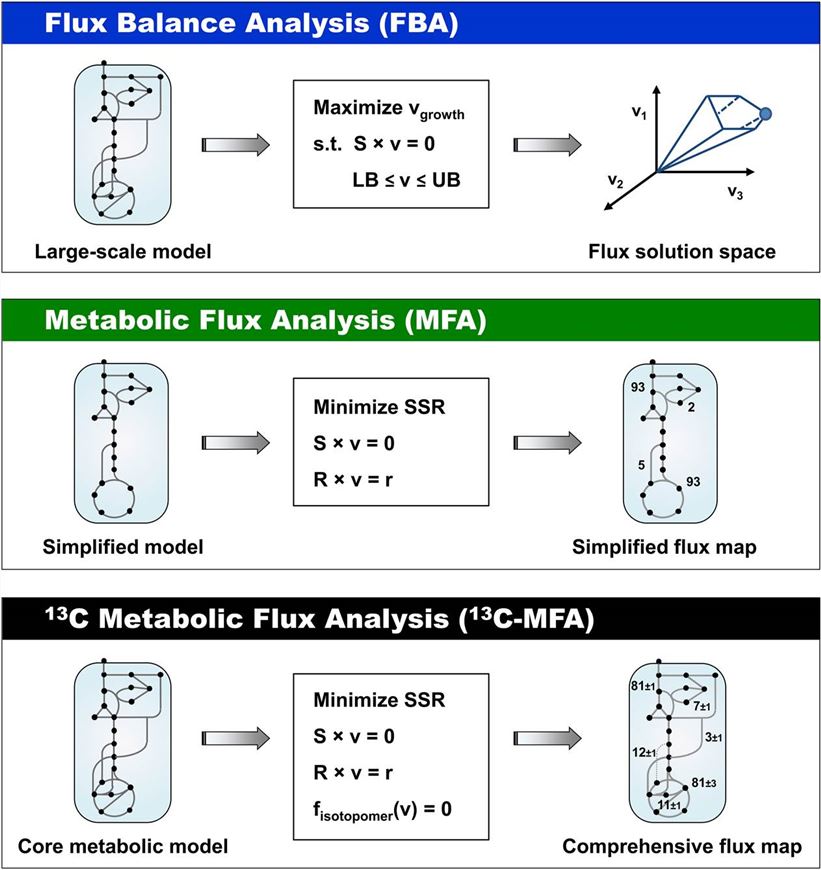Metabolic flux analysis (MFA) is a quantitative analytical method for representing intracellular reactions under proposed steady-state assumptions using a metric matrix model, which can be used to examine the rate of metabolite production and consumption in biological systems. Metabolic flux analysis offers a more thorough description of the physiology of the organism as well as an accurate quantitative description of its metabolic features. The impact of genetic and environmental perturbations can be properly assessed by comparing changes in metabolic fluxes, and the significance of particular pathways and reactions can be precisely described.
Our company provides reliable, rapid and cost-effective non-target and target MFA services based on highly stable, reproducible and sensitive isolation, characterization, identification and quantitative analysis systems to help accelerate our customers' research.
Service Overview

Our company provides an MFA platform for identifying regulatory networks that control structure and analyze metabolic pathways, and is broadly applicable to any metabolic system that can be described by a kinetic model. We use high-performance quantitative techniques to perform global flux analysis for predicted flux pathways without compromising data integrity.
Our services include experimental design, sample analysis, and data analysis. In innovative proteomics, whether you want to analyze general trends in metabolomics fluxes or a specific method, we can guarantee that the data will meet your needs.
Our company offers the following service components for MFA.
- Quantitative characterization of the complete metabolic process and its precise flux distribution.
- Identify rigid nodes of metabolic pathways and find entry points for genetic engineering modifications.
- Discovery of new metabolic pathways to facilitate understanding of physiology or pathology.
- Enables the prediction of biological phenotypes.
Service Process
(1) Experimental Design - We provide personalized experimental design according to your study subjects and study objectives.
(2) Sample Analysis - We can provide analysis of various metabolomic fluxes, such as glucose metabolic flux, glutamine flux, tricarboxylic acid cycle (TCA cycle) metabolic flux, etc.
(3) Data Analysis - We can provide the processing of raw mass spectrometry data, analyze mass spectrometry data, and realize the quantification of data and interpretation of results.
Research Capabilities
Based on high performance quantitative technology, Our company can provide MFA solutions without compromising data integrity. We have a variety of methods for MFA, including but not limited to:
- 13C metabolic flux analysis (13C-MFA)
- 13C dynamic metabolic flux analysis (13C-DMFA)
- Isotopic non-resting 13C metabolism (13C-NMFA)
- Dynamic metabolic flux analysis (DMFA)
- Chemometric metabolic flux analysis
Sample Requirements
Our company can perform assays on many types of samples, including cells, conditioned media, subcellular compartments, exosomes, tissues, blood, plasma, breast milk, skin, urine, feces, plants, microorganisms, and food. Nevertheless, our service requires only a minimum number of samples per analysis.
Lipid extraction should be performed immediately after the sample collection step; otherwise, samples should be stored at -80°C and transported on dry ice.
 Fig.1 Three main approaches for analyzing metabolic network models and quantifying intracellular metabolic fluxes: flux balance analysis (FBA), metabolic flux analysis (MFA) and 13C metabolic flux analysis (13C-MFA). (Antoniewicz M. R, et al. 2021)
Fig.1 Three main approaches for analyzing metabolic network models and quantifying intracellular metabolic fluxes: flux balance analysis (FBA), metabolic flux analysis (MFA) and 13C metabolic flux analysis (13C-MFA). (Antoniewicz M. R, et al. 2021)
Applications
In systems metabolic engineering, MFA services can be used to understand the physiology of cells under specific conditions and to predict their metabolic capacity following genetic or environmental disturbances.
MFA services can also be used to elucidate cellular mechanisms. By using stable isotope (e.g. 2H, 13C and 15N) labels, MFA can identify and quantitatively assess the metabolic effects of metabolic pathways by looking at the position of the isotope label in the metabolic pathway.
If you are looking for smarter, higher quality solutions that incorporate best practices, please feel free to contact us.
Reference
- Antoniewicz M. R, et al. (2021). "A Guide to Metabolic Flux Analysis in Metabolic Engineering: Methods, Tools and Applications." Metabolic Engineering. 63: 2-12.
Related Services
It should be noted that our service is only used for research, not for clinical use.


 Fig.1 Three main approaches for analyzing metabolic network models and quantifying intracellular metabolic fluxes: flux balance analysis (FBA), metabolic flux analysis (MFA) and 13C metabolic flux analysis (13C-MFA). (Antoniewicz M. R, et al. 2021)
Fig.1 Three main approaches for analyzing metabolic network models and quantifying intracellular metabolic fluxes: flux balance analysis (FBA), metabolic flux analysis (MFA) and 13C metabolic flux analysis (13C-MFA). (Antoniewicz M. R, et al. 2021)